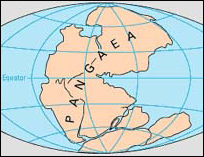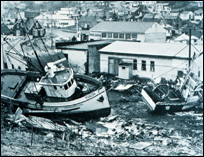| Until
the 20th century, philosophers and mathematicians long struggled
to understand the causes behind devastating earthquakes, with several
early scholars recognizing that quakes have geological causes. The
Roman philosopher Seneca knew that "it is useful to be assured
that the heavings of the earth are not the work of angry deities.
These phenomena have causes of their own." Aristotle suggested
earthquakes are the result of winds inside the Earth, caused by
the Sun's heat.
Theories abounded
until 1912, when German meteorologist Alfred Wegener published
two articles on the theory of continental drift. According to
the theory, the world's continents originally formed one whole
plate, which tore apart 200 million years ago, resulting in various
sections floating away. (View
USGS interactive tracking continental drift)
The
theory of plate tectonics grew out of continental drift theory,
and today it is widely accepted that the Earth's outer layer is
made up of roughly a dozen plates that are constantly drifting
apart from each other, or colliding together.
The Earth
is scarred with faults marking the points where tectonic plates
are very gradually continuing the processes of tearing apart or
crashing together. Along some fault systems, such as in parts
of California's famed San Andreas Fault, the area adapts to the
constant, slow movement of tectonic plates -- or creep -- by continually
adjusting, resulting in numerous small to moderate shocks and
tremors.
Conditions
are ripe for an earthquake when the Earth does not adjust properly
to creep, thereby allowing a great amount of strain to accumulate.
As pressure builds in the Earth's outer layer, and the two sections
of plate around a fault are forced together, stress and shifting
increases in the rocks underground.
If the approaching
earthquake is a large one, it may be preceded by foreshocks: small
shocks marking the movement of rocks beneath the Earth's surface,
occasionally followed by a series of infrequent shocks as the
two stirring tectonic plate masses lock together during movement.
The Earth
then reacts to this stress buildup by bending, until the pressure
becomes greater than the rocks themselves. When this happens,
the rocks break apart, a process called faulting. As faulting
occurs, the breaking rocks send out vibrations known as seismic
waves. The
concentric waves spread outward from the source, traveling at
different speeds and spreading across a wide range.
The U.S. Geological
Survey likens this effect to that of a stone being thrown into
water, with ripples moving outward from the point where the stone
enters the water. This point of origin for an earthquake is called
the "focus," and is often far below ground. Geologists
and geographers refer to the aboveground point of the earthquake's
origin as the "epicenter."
The zone around
an earthquake's epicenter is most vulnerable to damage. In this
area, the ground can crack and shift as much as several yards,
both horizontally and vertically.
The strength
and type of the seismic waves during an earthquake establish the
severity of damage a region will sustain during the quake.
There are
two classes of seismic waves: body waves, which travel quickly
through the dense rock deep in the Earth, and surface waves, which
travel more slowly through rock near the Earth's surface. Body
waves occur before surface waves.
There are
two types of body waves. P, or primary waves, which are the fastest,
move between 1 and 5 miles per second, and are capable of moving
through rock and liquids. Secondary waves -- or S waves -- move
more slowly, but cause more damage, as they make the ground shake
perpendicular to the direction in which the waves are traveling.
The
other seismic wave category is surface waves, which are even slower
than secondary waves, and continue for a longer period of time.
As the waves
travel through material, the material's density affects their
speed. This material composition determines the extent of vibrations
-- and therefore damage -- that the earthquake will ultimately
cause.
In areas with
a large amount of bedrock, for example, seismic waves are incapable
of traveling far, so damage to such areas tends to be more minimal.
In areas with loosely compacted soil, waves can travel farther,
and therefore incur more damage.
When an earthquake's
epicenter is located in or near a densely populated area, extensive
damage is possible because the seismic waves can bounce off each
other before dispersing. According to the Structural Engineers'
Association of Northern California, large amounts of soft soil
can increase seismic waves and worsen building displacement.
Aftershocks
can occur as the massive slabs of shifted rock settle into their
new positions. According to the USGS, aftershocks can cause major
difficulties for rescue services, and can  also
cause further damage to structures damaged in the initial quake. also
cause further damage to structures damaged in the initial quake.
When an earthquake
occurs under the ocean, it can tip off a tsunami: a sea wave that
spreads outward from the earthquake's epicenter. A tsunami is
generated when the seafloor experiences vertical displacement
during earthquakes and volcanic activity. The activity causes
the ocean surface to shift downward, and the water eventually
springs back violently, approaching a coastline at roughly 500
miles per hour and wreaking havoc on coastal areas.
In Papua New
Guinea, a magnitude 7.0 quake struck the north central coast in
July 1998, tipping off a series of three tsunamis that, according
to USGS, may have been the 20th century's most devastating. The
official death toll was 2,182, and 9,199 people were left homeless.
--
By Jessica Moore, Online NewsHour
| 








